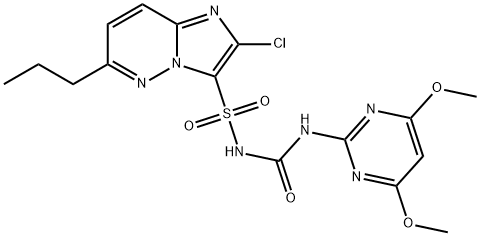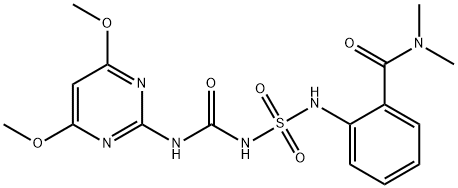Azimsulfuron
Synonym(s):N-{[(4,6-Dimethoxy-2-pyrimidinyl)amino]carbonyl}-1-methyl-4-(2-methyl-H-tetrazol-5-yl)-1H-pyrazole-5-sulfonamide
- CAS NO.:120162-55-2
- Empirical Formula: C13H16N10O5S
- Molecular Weight: 424.4
- MDL number: MFCD02102190
- SAFETY DATA SHEET (SDS)
- Update Date: 2024-12-18 14:15:30

What is Azimsulfuron?
The Uses of Azimsulfuron
Herbicide.
The Uses of Azimsulfuron
Azimsulfuron may be used as an analytical reference standard for the determination of the pesticide in:
- Paddy field water by direct injection using liquid chromatography-hybrid triple quadrupole-linear ion trap-mass spectrometry (LC-QqLIT-MS).
- Tap and leaching water samples by solid-phase extraction (SPE), followed by LC coupled to tandem mass spectrometry (LC-MS/MS).
What are the applications of Application
Azimsulfuron is Azimsulfuron is a molecular probe.
Definition
ChEBI: Azimsulfuron is an N-sulfonylurea that is urea in which a nitrogen attached to one of the nitrogens has been replaced by a 4,6-dipyrimidin-2-yl group while a hydrogen attached to the other urea nitrogen has been replaced by a [1-methyl-4-(2-methyl-2H-tetrazol-5-yl)-1H-pyrazol-5-yl]sulfonyl group. An acetolactate synthase inhibitor, it is used as a herbicide for the control of a variety of broad-leaved and sedge weeds in paddy fields and other aquatic situations. It has a role as a herbicide and an EC 2.2.1.6 (acetolactate synthase) inhibitor. It is an aromatic ether, a biaryl, a N-sulfonylurea, a member of tetrazoles and a pyrazole pesticide.
General Description
Azimsulfuron is a sulfonylurea based pesticide.
Agricultural Uses
Azimsulfuron (DPX‐A8947) is a new rice herbicide introduced in 1996 by DuPont for the control of broadleaf weeds (including hard‐to‐control perennials). At application rates of 8–20 g a.i. ha−1, it provides superior weed control, including E. crus-galli, when compared with the first‐generation sulfonylurea bensulfuron at 50–75 g a.i. ha−1. Azimsulfuron is targeted to replace or supplement bensulfuron in some applications. In Japan, in planted rice, azimsulfuron is used as a premixture with bensulfuron (6 + 30 g a.i. ha−1) to boost the activity against perennial weeds. Good control has also been reported of other members of the Echinochloa family, such as E. hispidula, E. oryzicola, and E. oryzoides. Other weeds controlled include Alisma lanceolatum, A. plantago‐aquatica, Butomus umbellatus, Cyperus difformis, Scirpus maritimus, S. mucronatus, S. supinus, Heteranthera limosa, Potamogeton nodosus, Ammannia coccinea, A. robusta, Bergia capensis, and Lindernia dubia.
Azimsulfuron is sold under the trade names “Gulliver” and “Azin.”
Safety Profile
Low toxicity by ingestion,inhalation, skin contact, and intraperitoneal routes. A mildeye irritant. When heated to decomposition it emits toxicvapors of NOx and SOx.
Safety Profile
Very unstable, explosivecompound. Very sensitive to heat. Samples have explodedduring analytical combustion. When heated todecomposition it emits toxic fumes of NOx. See AZIDES.
Properties of Azimsulfuron
| Melting point: | 170° |
| Density | 1.74±0.1 g/cm3(Predicted) |
| storage temp. | Sealed in dry,2-8°C |
| solubility | Solubility in organic solvents (g/l at 25 °C) Acetone 26.4 Acetonitrile 13.9 Ethyl acetate 13.0 Dichloromethane 65.9 n‐Hexane <0.2 Methanol 2.1 Toluene 1.8 |
| form | neat |
| pka | 3.6(at 25℃) |
| form | Solid |
| color | White to Off-White |
| Water Solubility | Solubility in water (g/l at 20 °C): 0.072 (pH 5) 1.050 (pH 7) 6.536 (pH 9). |
| BRN | 8284859 |
| CAS DataBase Reference | 120162-55-2(CAS DataBase Reference) |
| EPA Substance Registry System | Azimsulfuron (120162-55-2) |
Safety information for Azimsulfuron
| Signal word | Warning |
| Pictogram(s) |
 Environment GHS09 |
| GHS Hazard Statements |
H410:Hazardous to the aquatic environment, long-term hazard |
| Precautionary Statement Codes |
P273:Avoid release to the environment. |
Computed Descriptors for Azimsulfuron
New Products
(S)-3-Aminobutanenitrile hydrochloride 4-Methylphenylacetic acid N-Boc-D-alaninol N-BOC-D/L-ALANINOL Tert-butyl bis(2-chloroethyl)carbamate 3-Morpholino-1-(4-nitrophenyl)-5,6-dihydropyridin- 2(1H)-one Furan-2,5-Dicarboxylic Acid Tropic acid 1-Bromo-3,5-Di-Tert-Butylbenzene S-2-CHLORO PROPIONIC ACID ETHYL ISOCYANOACETATE 2-Bromo-1,3-Bis(Dimethylamino)Trimethinium Hexafluorophosphate 4-IODO BENZOIC ACID 3-NITRO-2-METHYL ANILINE 1-(2,4-DICHLOROPHENYL) ETHANAMINE (2-Hydroxyphenyl)acetonitrile 4-Bromopyrazole 2-(Cyanocyclohexyl)acetic acid 4-methoxy-3,5-dinitropyridine 1-(4-(aminomethyl)benzyl)urea hydrochloride 2-aminopropyl benzoate hydrochloride diethyl 2-(2-((tertbutoxycarbonyl)amino) ethyl)malonate tert-butyl 4- (ureidomethyl)benzylcarbamate Ethyl-2-chloro((4-methoxyphenyl)hydrazono)acetateRelated products of tetrahydrofuran








You may like
-
 Azimsulfuron 95.00% CAS 120162-55-2View Details
Azimsulfuron 95.00% CAS 120162-55-2View Details
120162-55-2 -
 Azimsulfuron CAS 120162-55-2View Details
Azimsulfuron CAS 120162-55-2View Details
120162-55-2 -
 1975-50-4 98%View Details
1975-50-4 98%View Details
1975-50-4 -
 2-HYDROXY BENZYL ALCOHOL 98%View Details
2-HYDROXY BENZYL ALCOHOL 98%View Details
90-01-7 -
 2-Chloro-1,3-Bis(Dimethylamino)Trimethinium Hexafluorophosphate 221615-75-4 98%View Details
2-Chloro-1,3-Bis(Dimethylamino)Trimethinium Hexafluorophosphate 221615-75-4 98%View Details
221615-75-4 -
 61397-56-6 CIS BROMO BENZOATE 98%View Details
61397-56-6 CIS BROMO BENZOATE 98%View Details
61397-56-6 -
 14714-50-2 (2-Hydroxyphenyl)acetonitrile 98+View Details
14714-50-2 (2-Hydroxyphenyl)acetonitrile 98+View Details
14714-50-2 -
 118753-70-1 98+View Details
118753-70-1 98+View Details
118753-70-1